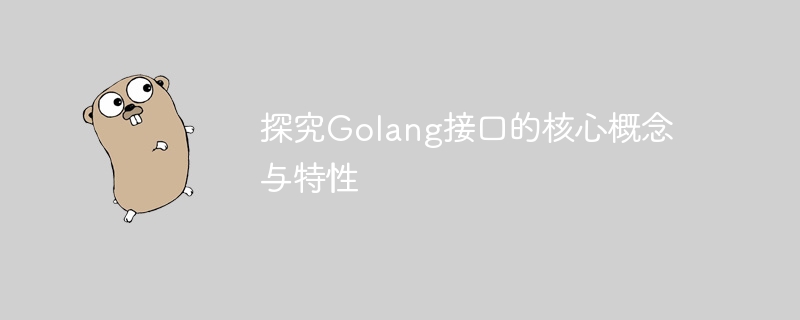Home >Backend Development >Golang >Explore the core concepts and features of Golang interfaces
Explore the core concepts and features of Golang interfaces
- WBOYWBOYWBOYWBOYWBOYWBOYWBOYWBOYWBOYWBOYWBOYWBOYWBOriginal
- 2024-03-06 18:36:041238browse

Golang is an open source programming language developed by Google. One of its design goals is simplicity and efficiency. In Golang, interface is a very important concept, which provides a mechanism to achieve abstraction and polymorphism. This article will delve into the core concepts and features of Golang interfaces and analyze them with specific code examples.
What is an interface?
In object-oriented programming, an interface is a specification that defines a set of method declarations. The concrete class that implements these methods is considered the implementation class of the interface. Interfaces provide a way to define the behavior of an object's methods without requiring the specific details of implementing those methods.
In Golang, an interface is a type that is defined by the signature of a set of methods. An object is considered to implement an interface as long as it implements all methods declared in the interface.
Definition of interface
In Golang, the definition of interface is very simple, as follows:
type Shape interface {
Area() float64
Perimeter() float64
}The above code defines an object named ShapeInterface, it contains two methods Area() and Perimeter(), the return type of these two methods is float64. Any type that implements these two methods declared in the Shape interface is deemed to implement the Shape interface.
Implementation of interface
The implementation of interface is implicit in Golang. As long as a type implements all the methods declared in the interface, it can be regarded as implementing the interface. The following is a specific implementation of the Shape interface:
type Rectangle struct {
Width float64
Height float64
}
func (r Rectangle) Area() float64 {
return r.Width * r.Height
}
func (r Rectangle) Perimeter() float64 {
return 2 * (r.Width + r.Height)
} In the above code, the Rectangle type implements the Shape declaration in the interface There are two methods, Area() and Perimeter(), so the Rectangle type is considered to implement the Shape interface.
Interface type variables
In Golang, interface type variables can store the value of any type that implements the interface. For example, we can define a function whose parameter is the Shape interface type:
func CalculateArea(shape Shape) float64 {
return shape.Area()
} and then pass the type that implements the Shape interface to CalculateArea function to calculate the area, as shown below:
func main() {
rect := Rectangle{Width: 5, Height: 10}
area := CalculateArea(rect)
fmt.Println("The area of the rectangle is:", area)
}Through the above code, we can see that although the parameter received by the CalculateArea function is the Shape interface type , but in fact what we pass is an instance of the Rectangle type, because the Rectangle type implements the Shape interface.
Empty interface and type assertion
In Golang, the empty interface interface{} can represent any type. Through the empty interface, you can implement generic types similar to those in Java or Python. At the same time, Golang also provides a type assertion mechanism, which can determine the actual type stored in an interface variable at runtime and convert it to the corresponding type through type assertion.
The following is a sample code showing the usage of empty interface and type assertion:
func PrintType(value interface{}) {
switch v := value.(type) {
case int:
fmt.Println("The value is an integer:", v)
case float64:
fmt.Println("The value is a float:", v)
}
}
func main() {
PrintType(10)
PrintType(3.14)
}In the above code, the PrintType function receives a parameter of empty interface typevalue, and determine the actual type of value through type assertion in the function body, and then process it separately.
Summary
This article explores the core concepts and features of Golang interfaces and explains them through specific code examples. Through interfaces, Golang implements abstraction and polymorphism in object-oriented programming, making the code more flexible and easy to expand. At the same time, empty interfaces and type assertions provide Golang with the ability to handle unknown types and dynamic type conversion. A deep understanding of and proficient use of the concept of interfaces will help improve the design and development quality of Golang programs.
The above is the detailed content of Explore the core concepts and features of Golang interfaces. For more information, please follow other related articles on the PHP Chinese website!

